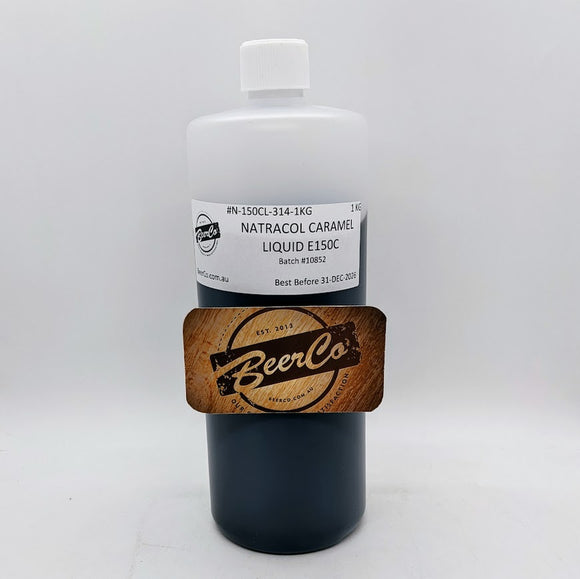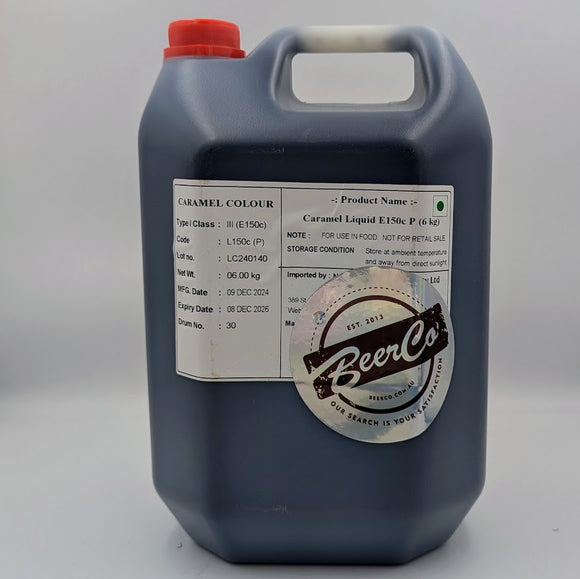Caramel Colour Liquid E150C Colour is a reddish-brown coloured liquid obtained by heating food grade carbohydrate (corn origin) along with food grade catalysts in controlled heat and pressure environment.
150c (Class III): Ammonia Caramel:
- This is made by heating carbohydrates with ammonium compounds.
- It has a positive colloidal charge.
- It is more commonly used in products like beer and soy sauce.
Caramel Colour Liquid E150c: This is a specific type of caramel color, Class III (Ammonia Caramel). It's a concentrated liquid made by heating carbohydrates with ammonia compounds, resulting in a reddish-brown color that's stable in alcohol and salt-rich environments. Its primary purpose is to add color.
The E150c caramel colour, also known as **Ammonia Caramel** or Class III caramel, is a very common food additive. It is favoured for its **red-brown colour** and its excellent stability in solutions that are high in **alcohol** and **salt**.
Here are the key beverages and foods where E150c is typically used:
Beverages
- Beer: This is one of the most common applications. E150c is widely used to achieve a consistent, dark brown colour in products like stouts and dark ales.
- Spirits and Liquor: Used in some whiskies, brandies, and rums to standardise the colour and give the perception of age or richness.
- Flavoured Alcoholic Beverages (like certain liqueurs).
- Some types of Soft Drinks: (though E150d is more common for colas due to its acid stability, E150c is also used in some formulations).
Foods
Sauces and Condiments:
- Soy Sauce: Its stability in high-salt environments makes it an ideal choice for this product.
- Gravy Mixes and Gravy Browning: Used to give a deep, rich brown colour.
BBQ Sauce and other savoury brown sauces.
- Baked Goods & Confectionery:
- Confectionery and licorice.
- Some Cereals and baked goods (like breads, cakes, and cookies) for a rich, warm brown tone.
Soup and Seasoning Blends: - Other Savoury Products: Often found in processed meats and pet food for colour consistency.
In summary, E150c is the go-to caramel colour for products that have a neutral to moderate pH and contain significant levels of alcohol or salt.
Pack Sizes:
- 1 Kg
- 6 Kg (SAVE 44% OFF 1Kg Price)
- 24 Kg (SAVE 52% OFF 1Kg Price)
Dosage Guidance:
Starting dose rate for colour is generally 0.5% moving up depending on what your desire is to achieve in terms of colour and shade.
SPECIFICATION:
Sr No. |
Specification |
UoM |
Requirements |
| 1 | Physical appearance | Reddish-brown viscous liquid | |
| 2 | Colloidal charge | Positive | |
| 3 | Colour bound by DEAE cellulose | % | (Max.) 50.00 |
| 4 | Colour bound by phosphoryl cellulose | % | (Min.) 50.00 |
| 5 | Specific gravity (at 20°C) | 1.255 – 1.290 | |
| 6 | Colour intensity (at 610nm, 0.1% solution) | 0.13 – 0.15 | |
| 7 | Colour intensity (ODB) | 0.08 – 0.36 | |
| 8 | Colour intensity (at 530nm, 0.1% solution) | 0.36 – 0.40 | |
| 9 | pH | 3.90 – 4.60 | |
| 10 | Acid stability Stable | ||
| 11 | Salt stability (15% salt solution) | No precipitation | |
| 12 | Viscosity (at 20°C) | cps | (Max.) 1500 |
| 13 | Copper (Cu) | ppm | (Max.) 20.00 |
| 14 | Lead (Pb) | ppm | (Max.) 2.00 |
| 15 | Arsenic (As) | ppm | (Max.) 1.00 |
| 16 | Cadmium (Cd) | ppm | (Max.) 1.00 |
| 17 | Mercury (Hg) | ppm | (Max.) 0.10 |
| 18 | 4-Methylimidazole | ppm | (Max.) 200 |
| 19 | Total nitrogen | % | 0.70 – 3.30 |
| 20 | Total sulphur | % | (Max.) 0.20 |
| 21 | Ammoniacal nitrogen | % | (Max.) 0.30 |
| 22 | Total plate count | CFU/g | (Max.) 200 |
| 23 | Yeasts | CFU/g | (Max.) 100 |
| 24 | Mould | 24 CFU/g | (Max.) 100 |
| 25 | E. coli | Absent in 1g | |
| 26 | Salmonella | Absent in 25g | |
| 27 | GMO Free | Yes | |
| 28 | Irradiation free | Yes | |
| 29 | Halal | Certified | |
| 30 | Kosher | Certified | |
| 31 | Vegetarian | Suitable | |
| 32 | Allergen | Contains sulphite < 10 ppm |
Batch Codes:
- Lot no. LC240140 Best Before: 8 Dec 2026
Ingredients:
- Caramel (150c).
Standard Packing:
6 Kg HDPE Jerry Can with a tamper evident lid.
Labelling:
Label displays product name, code, lot number and other information as standard.
Recommended Storage:
Store in ambient temperature (max. 25°C) and relative humidity below 60. Protect from air, light, moisture and heat. Prolonged exposure to air, light, moisture and heat degrades the colour strength.
Recommended Shelf Life:
24 months from the date of manufacture for unopened packs under specified storage condition. Use the product quickly after opening.
Handling:
Shake well before use. Avoid contact with eyes and skin.


